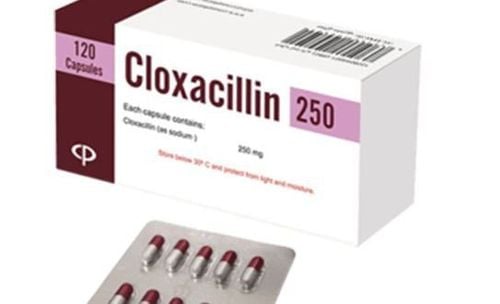This is an automatically translated article.
Cadifaxin 500 belongs to the group of antiparasitic, anti-infective, antiviral, antifungal drugs used in the treatment of respiratory tract infections. Follow the article to better understand Cadifaxin 500 and its uses.
1. What is Cadifaxin 500?
What is Cadifaxin 500? Cadifaxin 500 is a drug belonging to the group of anti-parasitic, anti-infective, anti-viral, anti-fungal drugs. Cadifaxin is indicated for use in the treatment of respiratory tract infections, infections caused by a number of Gram-positive and Gram-negative bacteria, including penicillinase-producing Staphylococcus, infections of the urinary tract, respiratory tract, skin and soft tissue.
Cadifaxin 500 USP (blister) is manufactured in US Pharma USA, in the form of tablets. Cadifaxin drug ingredients: Cephalexin monohydrate
Cephalexin is a bactericidal antibiotic active against a wide range of gram-positive and gram-negative bacteria. Cephalexin has a medium spectrum of activity, active against gram-positive bacteria such as staphylococci, streptococci, pneumococcus (except methicillin-resistant streptococci). Besides, Cephalexin is also effective against some gram-negative bacteria such as E.coli, Klebsiella pneumoniae, Proteus mirabilis and Shigella. There are resistant strains: Enterococcus, methicillin-resistant Staphylococcus, Proteus with positive indole reaction, Enterobacter, Pseudomonas aeruginosa, Bacteroides.
2. Dosage - How to take Cadifaxin 500
The drug Cadifaxin 500 is taken orally. Patient dosage can refer to the following:
Take the drug 1 hour before meals. The usual duration of treatment is from 7 to 14 days. Adults: 0.5 g - 1 g / time, drink about 6 hours. Children: 25 - 50mg/kg/day, divided into 4 times. In case of severe infection, the dose must be doubled. Pharyngitis and acute cystitis: daily dose can be divided into 2 times. Otitis media: 75-100mg/day/kg, divided into 4 times. Beta-hemolytic infections, minimum treatment duration ≥ 10 days. It should be noted: The above drug dosage is for reference only, when using the drug, the patient should strictly follow the dosage and recommendation of the doctor.
3. Contraindications when using the drug Cadifaxin
Contraindicated when using Cadifaxin in the following cases:
Patients allergic to any component of the drug Contraindicated in patients with a history of allergy to Cephalosporins and history of anaphylaxis due to Penicillin .
4. Treatment of missed dose or overdose of Cadifaxin
Missed dose: If you forget to take a dose, take it as soon as possible. However, if it is almost time for your next dose, skip the missed dose and take your next dose at the scheduled time. Never take double the prescribed dose. Overdose: Using 500 mg of Cadifaxine more than prescribed by your doctor can cause symptoms such as: Nausea, vomiting, epigastric discomfort, diarrhea and hematuria. If there are abnormal symptoms when overdose, it is necessary to immediately notify the doctor or medical person in charge for timely treatment.
5. Side effects when taking Cadifaxin 500mg
Side effects when taking Cadifaxin 500mg as follows:
Digestive disorders: Diarrhea, nausea, vomiting, dyspepsia, anorexia, abdominal pain, epigastric discomfort. Allergic reactions, eosinophilia, angioedema, anaphylactic reactions, neutropenia, superinfection, pseudomembranous colitis. Skin: Stevens-Johnson syndrome, erythema multiforme, toxic epidermal necrolysis, skin rash, urticaria, Lyell's syndrome, Quincke's edema. Liver: Hepatitis, cholestatic jaundice. Genitourinary: genital candidiasis, vaginitis, vulvar pruritus. Headache, dizziness, tinnitus, deafness and behavioral changes in young children when taking Cadifaxin.
6. Drug interactions
Cadifaxine contains high doses of Cephalosporins and other drugs that are also nephrotoxic such as Aminoglycosides or potent diuretics (eg, Furosemide, Ethacrynic Acid and Piretanide) may adversely affect renal function. Clinical experience shows no adverse effects with cefalexin at the recommended dose levels. There have been a few reports of Cephalexin reducing the effect of estrogen in oral contraceptives. Cholestyramine binds to Cephalexin in the intestine, slowing the absorption of the drug. This interaction may be of little importance. Probenecid increases serum concentrations and increases the half-life of Cephalexin. To avoid drug interactions, patients need to inform the doctor about the drugs, herbs, and supplements they are using.
7. Notes when using the drug Cadifaxin
During the use of Cadifaxin, patients should pay attention:
Long-term use of the drug may cause superinfection with non-susceptible bacteria. Renal impairment: the dose should be reduced and the patient closely monitored. Check hematopoietic, renal and hepatic function during long-term treatment. The patient has a history of gastrointestinal disease, especially inflammatory bowel disease. For pregnant or lactating women: Do not use for pregnant and lactating women. For drivers and machine operators: Use caution when driving and operating machinery. Cadifaxin is an antibiotic that needs to be used under the direction of a specialist doctor and clinical pharmacist to achieve the best results, to avoid unwanted effects.
Follow Vinmec International General Hospital website to get more health, nutrition and beauty information to protect the health of yourself and your loved ones in your family.
Please dial HOTLINE for more information or register for an appointment HERE. Download MyVinmec app to make appointments faster and to manage your bookings easily.













